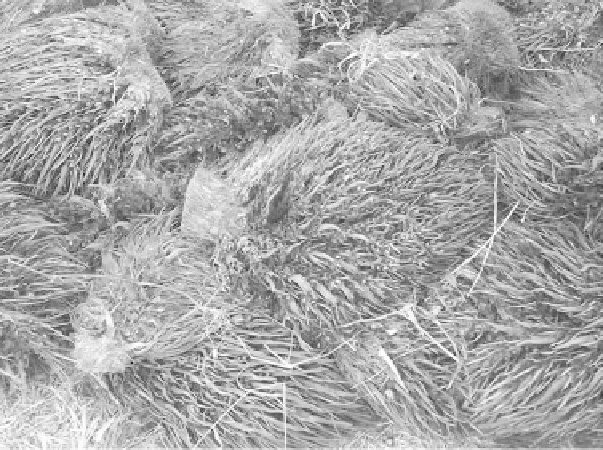Environmental Engineering Reference
In-Depth Information
FIGure 17.7 (see color insert)
Empty fruit bunches.
of 136-148 palm trees/ha of land in Malaysia. On the basis of the total matured planted area of oil
palm in 2008, 3.91 million ha, there are currently approximately 531-578 million matured palm
trees in the country. Assuming 5% of these matured oil palm planted areas are replanted annually
and assuming 148 palm trees/ha of land, 28.9 million palm trees will be available each year with a
contribution of 17.3 million tons of trunk biomass and 3.3 million tons of frond biomass.
On the basis of the above estimates and 10.4 tons of biomass per hectare produced during the
pruning (Chan 2009) and normal harvesting of fronds, a total of 40.66 million tons of frond biomass
was obtained in 2008.
17.6 avaIlaBIlIty oF eFB, shell, FIBer, and Pome
In general, FFB contain approximately 20-22% palm oil, 6-7% palm kernel, 14% fiber, 7% shell,
and 23% EFB (Ma 2002). During the processing of FFB in the palm oil mill, the main products are
palm oil and palm kernel with other co-products including EFB, fiber, shells, and POME. These
co-products are obtained at different stages of the milling and nut crushing processes.
The FFB received are subjected to sterilization in a vessel with steam at 140°C at 3 bar. After
that, the sterilized FFB are threshed to remove the palm fruits from their spikelets. Sterilizer
condensate is produced as a byproduct.
The crude palm oil is mechanically pressed out from the sterilized palm fruits by a screw press.
The oil is then clarified and an effluent is produced from the sludge and centrifugal waste. A press
cake containing fibers and nuts is another product from the screw press. The nuts are separated from
fibers in a vertical column having an upward airflow.
The nuts are cracked in either centrifugal nut crackers or a ripple mill, and the shells are separated
from the cracked mixture by a pneumatic dry air separator, a wet hydrocyclone, or clay bath. Here,
hydrocyclone washings are generated as waste. The sludge and centrifugal waste, the sterilizer
condensate and hydrocyclone washings are mixed together to form POME, which normally receives
further treatment through a pond system. The fibers and shells generated are used as boiler fuel.
Malaysia had more than 4.48 million ha of land under oil palm cultivation. In 2008, the country
produced 17.73 million tons of crude palm oil from the processing of 87.74 million tons of FFB
(MPOB 2009a). On the basis of these figures, the type and amount of biomass generated and its heat
value was calculated (Table 17.2).

